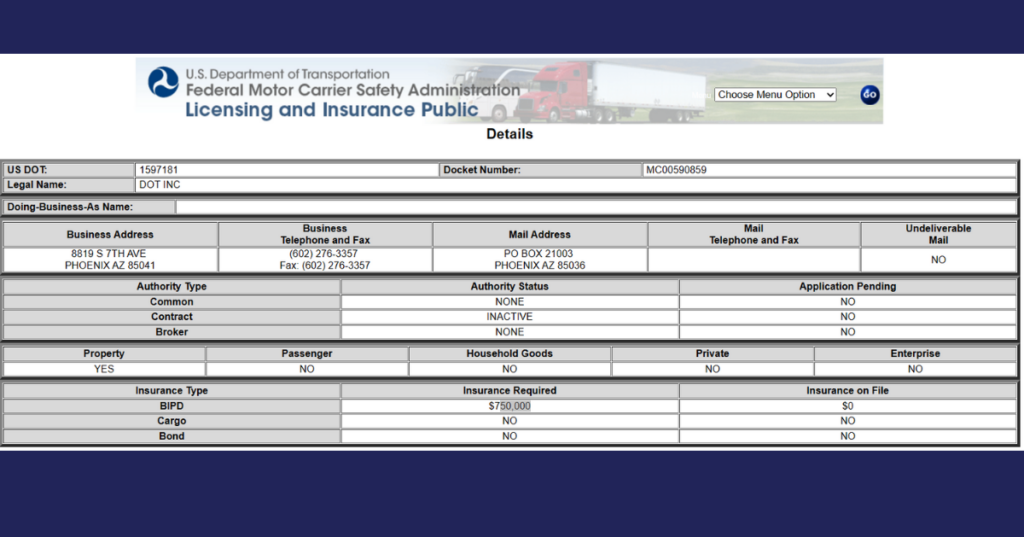Liability is a continuously changing part of logistics management. However, understanding who carries the liability burden can be confusing at best, and navigating the trucking data within the SAFER Web Snapshot, operated by the Federal Motor Carrier Safety Administration (FMCSA), is still tricky. Let’s take a deeper look at why a broker would need this FMCSA data information and how it amounts to both a DOT Authority check and protection against liability.
Why Would a Broker Want to Confirm a Trucking Company Has Proper Interstate Insurance?
Many brokers have asked, “How do I know if a trucking company has insurance,” but it’s not only about verifying the data. It’s about verifying the data is accurate and accessible more regularly than the initial onboarding of a new trucking company.
The answer comes down to liability and protecting their business against potential litigation due to negligent selection.
In 2011, DC Velocity reported how a shipper, broker or other third-party entity may retain liability when hiring truckers and other carriers to transport a load. “The March 30 ruling by a 3rd District Illinois Appellate Court panel is the latest setback in C.H. Robinson’s efforts to avoid culpability for the incident. It also sends a strong and disturbing message to shippers and brokers that they could be held accountable for accidents involving a trucker they hire to move goods, even if they contend the trucker and driver were not employees and were hired to simply transport a shipment.”
Such risk is the exact reason why more companies continue to rely on The Federal Licensing and Insurance Systems (L&I) database, a subset of the SAFER trucking website.
How Does the Licensing and Insurance Public Database Differ From SAFER Snapshot?
The SAFER trucking Snapshot does a world good in providing a first-line view of a trucking company’s safety profile and authorization to operate. It includes the basic contact information, it’s granted classification operating authority, and the type of cargo it carries. The SAFER Snapshot is the US DOT safety and status review, but understanding the granularities of authority, including its insurance history and status, is found within the L&I database.
As shown in this L&I example below, an individual can evaluate the common carrier, contract, and broker authority granted by the DOT.

The page is accessed in the same way as the SAFER company Snapshot, but it requires a careful eye to review the types of cargo it can transport, broken into five overarching categories, including:
- Property.
- Passenger.
- Household Goods.
- Private.
- Enterprise.
Furthermore, the data within the listing shows what insurance is required for the Bodily Injury Property Damage requirement (BIPD), Cargo for Household Goods carriers, or Bond for the respective authorized company. If a user wishes to dig deeper, accessing the specifics of the dataset, reviewing the insurance underwriter and stipulations on this page is possible too.
The Benefits of Improved Insurance and Authority Review via Digital Data Sharing
While having the data to understand a company’s insurance and authority is a great start to sourcing transportation, manual review of the data is overwhelming.
Reviewing data and keying it into your systems becomes a balancing act between time and effort versus risk. How much time can you truly devote to reviewing the data regularly? It’s your choice to explore the legal liability that lurks should a freight brokerage or shipper hire negligently, and if you’re on the wrong side of an incident, you will endure a higher operating cost.
Companies that wish to improve the management of third-party companies and service providers can further reduce their liability by automating the process with intuitive data feeds that offer:
- Streamlined integration to your transportation management system.
- Accessibility via the interface without the added risk of human error.
- Creating a searchable record for review upon request.
- Maintaining integrity and regularity of data updates.
But how do you achieve that goal without building an endless code stream to the FMCSA or L&I site? It’s much easier than many realize.
Boost Trucking Insurance Analysis With Carrier Details
The true reality is that manually reviewing the L&I data is as troublesome as looking up an individual carrier and reviewing its authority within the SAFER Web database. It’s time for a better approach to combing through this treasure trove of information. Grow your business with a faster way to approach FMCSA insurance look-ups, working with Carrier Details. Connect with a Carrier Details team member to get started.
